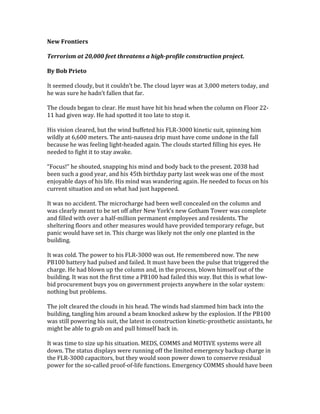
New frontiers
- 1. New Frontiers Terrorism at 20,000 feet threatens a high-profile construction project. By Bob Prieto It seemed cloudy, but it couldn’t be. The cloud layer was at 3,000 meters today, and he was sure he hadn’t fallen that far. The clouds began to clear. He must have hit his head when the column on Floor 2211 had given way. He had spotted it too late to stop it. His vision cleared, but the wind buffeted his FLR-3000 kinetic suit, spinning him wildly at 6,600 meters. The anti-nausea drip must have come undone in the fall because he was feeling light-headed again. The clouds started filling his eyes. He needed to fight it to stay awake. “Focus!” he shouted, snapping his mind and body back to the present. 2038 had been such a good year, and his 45th birthday party last week was one of the most enjoyable days of his life. His mind was wandering again. He needed to focus on his current situation and on what had just happened. It was no accident. The microcharge had been well concealed on the column and was clearly meant to be set off after New York’s new Gotham Tower was complete and filled with over a half-million permanent employees and residents. The sheltering floors and other measures would have provided temporary refuge, but panic would have set in. This charge was likely not the only one planted in the building. It was cold. The power to his FLR-3000 was out. He remembered now. The new PB100 battery had pulsed and failed. It must have been the pulse that triggered the charge. He had blown up the column and, in the process, blown himself out of the building. It was not the first time a PB100 had failed this way. But this is what lowbid procurement buys you on government projects anywhere in the solar system: nothing but problems. The jolt cleared the clouds in his head. The winds had slammed him back into the building, tangling him around a beam knocked askew by the explosion. If the PB100 was still powering his suit, the latest in construction kinetic-prosthetic assistants, he might be able to grab on and pull himself back in. It was time to size up his situation. MEDS, COMMS and MOTIVE systems were all down. The status displays were running off the limited emergency backup charge in the FLR-3000 capacitors, but they would soon power down to conserve residual power for the so-called proof-of-life functions. Emergency COMMS should have been
- 2. available, but likely the damage to the FLR-3000 was more extensive than he realized. At least it had saved his life, at least so far. He still had oxygen in the FLR-3000 thanks to the NASA contract, which he had worked on as a young engineer. Its predecessor, the original FLR-1000, had been developed for constructing extraplanetary bases before being modified and adapted for use in extreme construction environments right here on Earth, that is, if you can count being 6,600 meters up as still being on Earth. His suit was intact, thanks to the hardening provided by the FLR-3000 nanocladding. He had oxygen, but the temperature was already dropping as the latent heat of the suit slowly was drawn away by the high-altitude winds, part of any extreme skyscraper construction project. He looked around, spinning slowly once again. His safety drone had found him. The advantage of being a safety inspector was that you had your own personal safety drone and not one of the models shared by a typical work crew of 10. The drone appeared undamaged from the explosion, probably blown clear by the blast. It must have found him by tracking his GPS emergency signal. It was the last of the proof-of-life systems to stay powered. Proof of life—they should maybe better call it proof of death, but that’s not a great marketing strategy. In the distance he thought he could see the flashing red and blue NAV lights of EMT drones. Hopefully, these would be the heavy-lift variety, because the FLR-3000 kinetic models weigh almost 2,000 kilos. The ride down would not be pleasant in these winds, but the EMT drones, a fixture on all extreme engineering projects, would do their job just as the FLR-3000 had done its. The best he could tell, there were no serious injuries, but soon the pain would set in. He was going to have to get his safety drone an upgrade. Flowers didn’t seem appropriate. The clouds started to return. His mind wandered. Who had placed the microcharge, and why had earlier inspections failed to find it? This was not something that a final structural inspector at 6,600 meters would normally look for. He felt a jerk as the EMT drone captured his kinetic suit and cut off the one remaining safety tie. Blood pulsed through his veins as the EMT drone descended and the heat loss slowed. The pain he thought he might avoid was here now. “Alex, you will be OK,” he said to himself. The clouds returned. The story as published may be found at: http://enr.construction.com/opinions/viewpoint/2013/1030-Construction-ScienceFiction-New-Frontiers.asp
